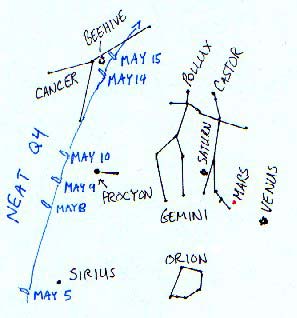C/2001 Q4 was discovered by the Near Earth Asteroid Tracking (NEAT) program at Palomar Observatory. Recently, Q4 has been visible in the Southern Hemisphere, but during the first week in May, it will be coming into view in the United States. This will also be its time of peak brightness.
Comets originate in the farthest reaches of our solar system, the Oort Cloud. This layer of dust and ice surrounds our solar system like a snowball, only several trillions of miles away, about halfway between our sun and its nearest star neighbors. Occasionally, one of the dirty chunks of ice is knocked loose of the cloud and begins traveling towards the sun - slowly at first (which can mean a few thousand years), then picking up speed as it nears the sun.
The ice ball, usually several miles wide, warms up as it approaches the sun. This causes cracks in its surface, which in turn allow dirt and gases to escape from its core. The gasses form an atmosphere, or coma, around the ice ball. As the comet nears the sun, the solar winds blow the coma away from the sun, creating the comet's distinctive tail. Some comets even have two tails, one made of gases and one made of dust.

One of the exciting things about comets is that one can't predict what they will look like. They can be bright enough to see with the naked eye, even in daylight, or so dim that they can barely be picked out through a telescope. Sometimes the pressure even causes them to crack up and disappear.
Q4 will be visible in the early evening, so any of the days following the full moon on May 5 will be fine for observing. Begin looking for it in the southwest at dusk. On May 5, it will be just above the horizon, to the left of Sirius, the bright star in Canis Major. By May 9 and 10, it will be to the left of Procyon in Canis Minor. Castor and Pollux, in Gemini, will point toward the comet on the May 14 and 15, and it will be tantalizingly close to M44, the Beehive Cluster in Cancer. (Even if you can't see the comet, look directly west and admire the nice grouping of Venus, Mars, and Saturn at the feet of Castor.)
If you have never seen a comet before, you may be initially disappointed in what you see. First, while you will be able to observe the comet's motion over a period of nights, you will not see it "streak across the sky" before your eyes. Also, just as with the deep sky objects, what you see with binoculars or even a telescope is considerably different than the fabulous comet photographs you have seen. Don't be dismayed if you can only see a fuzzy spot or a slight elongation. That is perfectly normal.
The current prediction is that Q4 will reach peak brightness, magnitude 2.5, on May 6, and will lose about one degree of magnitude every 5 to 7 days thereafter.
Magnitude 2.5 should be visible to the naked eye from a darkish urban location. That is approximately the same brightness as the two stars at the bottom of the Big Dipper's bowl.

The Piker Press moderates all comments.
Click here for the commenting policy.